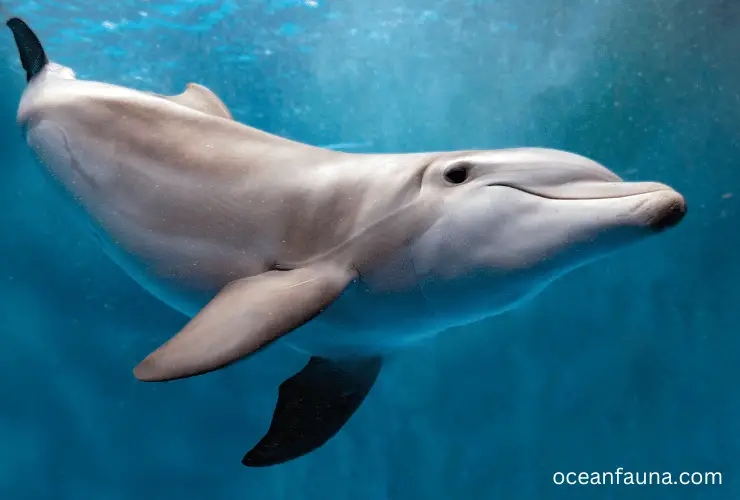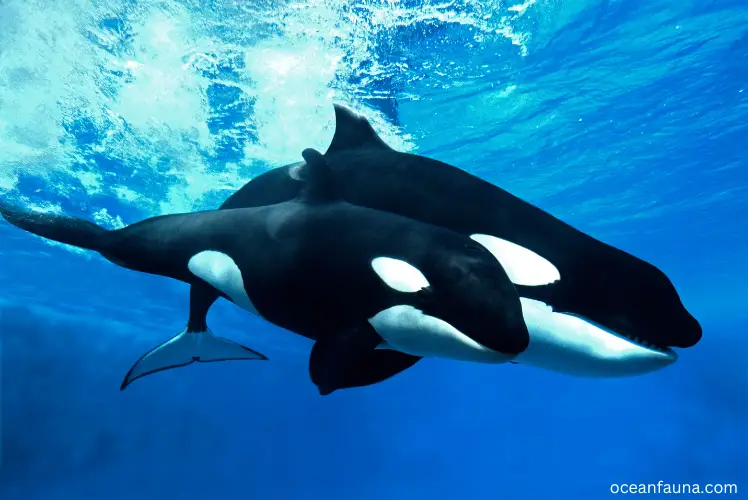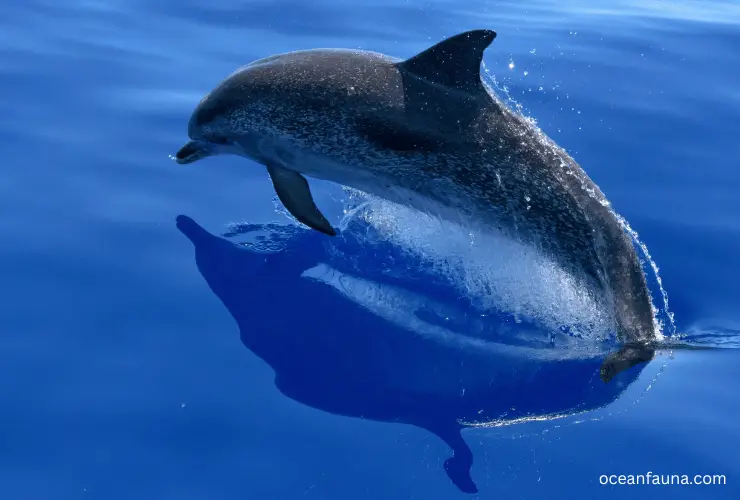Different species and sizes of dolphins have varying swimming speeds. Orca, for example, is capable of swimming up to 56 km/h. However, when travelling, an optimal speed for dolphins is about 6-9.5 km/h.
In this article, I will provide additional information about the speed of dolphins. I will cover which dolphins are faster, their swimming techniques, and other related details.
How Fast Are Dolphins?
As mentioned before, dolphins are known for their incredible swimming abilities. However, their speed may vary based on their species and size. For instance, the orca dolphin can swim up to 56 km/h, making it one of the fastest marine mammals in the world. The short-beaked common dolphin is also a swift swimmer and can reach speeds of up to 60 km/h.
Another popular dolphin species, the bottlenose dolphin, has a maximum swimming speed of 22 mph (35 km/h). This speed is faster than that of the fastest human swimmers. When the bottlenose dolphin is cruising, its speed is around 5 mph (8 km/).

However, their optimal travel speed is about 6-9.5 km/h. This speed allows them to effectively conserve energy while navigating through the water for long distances. If dolphins have a wave behind them or the bow wave of a boat to carry them along, they can go much faster.
For instance, they might get up to about 17 mph (27 km/h) over very short distances, for example, to do a big jump out of the water.
How Do Dolphins Swim?
Dolphins are known for being exceptional swimmers, with their bodies seemingly gliding effortlessly through the water. To swim, dolphins primarily rely on the movement of their tails, also known as flukes.
When swimming, dolphins move their bodies up and down in a rhythmic motion, which causes their tails to move up and down as well. This movement propels the dolphin forward through the water. The faster the dolphin moves its body and tail, the more quickly it will swim.
Additionally, the tail fluke is instrumental in controlling the direction of the dolphin’s swim. Dolphins can change direction and make turns by moving their tail fluke up or down or from side to side. This is particularly useful for hunting and manoeuvring in the ocean.
There are many different types of dolphins, each with their own unique swimming abilities. For example, the common dolphin is known for its speed. In contrast, the spinner dolphin is known for its acrobatic abilities, regularly leaping out of the water and spinning in mid-air.
What Is the Fastest Dolphin Specie?
The fastest dolphin species is the short-beaked common dolphin, scientifically known as Delphinus delphis. This majestic creature holds the record for being the swiftest marine mammal, capable of reaching speeds of up to 60 km/h or 37 mph.
This means that these dolphins can easily outrun most of their predators and travel long distances in a relatively shorter amount of time than other marine animals.
Short-beaked common dolphins have a sleek and streamlined body shape that makes them well-suited for speed. Their bodies are designed to reduce drag as they swim, allowing them to move through the water with minimal energy expenditure.

Additionally, their powerful tails and strong flippers enable them to propel themselves forward at high speeds while manoeuvring through the water with agility.
These playful and social creatures are commonly seen riding on swells and ship’s wakes, using these natural features of the ocean to boost their speed even further. Short-beaked common dolphins are often observed leaping and jumping out of the water, demonstrating their incredible speed and strength.
Despite their impressive speed, these dolphins are not the only ones capable of swift swimming. Other dolphin species, such as the orca, also known as the killer whale and the common bottlenose dolphin, can also reach high speeds of up to 60 km/h or more. However, the short-beaked common dolphin holds the title of being the fastest of them all.
Speed of Other Dolphins Species
Orca

The orca, or killer whale, is a species of dolphin that is able to reach speeds of up to 56 km/h (35 mph). These large and powerful marine mammals are some of the most adept hunters in the ocean. Orcas use their speed and agility to chase down their prey, diversifying their diet by hunting various animals.
Common Bottlenose Dolphin
The bottlenose dolphin is a species of dolphin known for its friendly nature and intelligent behaviour. Despite their relatively smaller size, these dolphins can swim up to 22 mph (35 km/h). They also have the advantage of being able to manoeuvre quickly and change direction instantly.
Spinner Dolphin
Spinner dolphins are well-known for their acrobatic abilities. They typically swim at a speed of 3-7 mph, which is not very fast. However, when they are trying to escape predators or catch prey, they can reach speeds of over 20 mph.
Hector’s Dolphin
Hector’s dolphin is one of the smaller dolphin species and is a slow swimmer. They can swim up to 6.8-7.8 mph (11-12.5 km/h) for a sustained period. This enables them to keep pace with larger dolphins and effectively search for food.
Striped Dolphin
The striped dolphin is a fast and agile species that can swim up to 23 mph. They often ride the waves created by boats or other dolphins, a behaviour known as bow-riding. This makes them one of the fastest marine mammals. They can reach these high speeds while hunting, playing, or when they are in danger.
Indo Pacific Humpbacked Dolphin
The Indo-Pacific humpbacked dolphin is a type of dolphin that can be found in the ocean. They are not very fast, usually swimming at around 4.8 kph, but are good at jumping out of the water. Unlike other dolphins, they don’t ride the bow of boats.
They are friendly and like to play with each other, and sometimes jump out of the water in groups. This is a way for them to move away from danger or catch food quickly.
How Fast Can Dolphins Swim in Knots?
According to observations of four large groups of dolphins, they can swim at a sustained speed ranging from 14 to 18 knots. It is important to note that this speed may vary depending on factors such as the dolphin species, physical condition, and environmental factors.

While dolphins are known to be fast swimmers, it is worth noting that certain marine animals are capable of much higher speeds, such as the blackfish, which are able to maintain speeds of approximately 22 knots.
Furthermore, some individual killer whales have been observed swimming at even faster speeds than the blackfish.
Knots are a unit of measurement used in nautical navigation, with 1 knot being equivalent to around 1.15 miles per hour. Thus, the sustained speeds at which dolphins can swim in knots roughly translate to 16 to 21 miles per hour, which is still very impressive.
How Fast Are River Dolphins?
River dolphins have a top speed of around 35 mph (56 km/h). However, this speed is relatively slow compared to other aquatic animals, such as sharks or killer whales. This slower speed is because their neck vertebrae are not fused, which gives their necks more flexibility but prevents them from swimming as fast.
Specifically, the lack of fused neck vertebrae allows river dolphins to turn their heads without shifting their entire bodies. This gives them greater manoeuvrability in the water, but it also means that they cannot generate as much speed as animals with more rigid necks.
While they may not be the fastest swimmers in the water, river dolphins are highly adapted to their environment and are skilled navigators. They are able to navigate complex river systems and use echolocation to locate prey and avoid obstacles.
Are Marine Dolphins Faster Than River Dolphins?
Yes, marine dolphins are generally faster than river dolphins. This can be attributed to the different environments in which they live.
Marine dolphins have evolved to live in the open ocean, where they have to swim long distances and compete with other fast-swimming marine animals for food. In contrast, river dolphins live in shallow, murky rivers where they do not need to swim great distances to find food.
Apart from their swimming speed, there are other differences between river and marine dolphins. For instance, river dolphins have smaller eyes that are poorly developed because they have adapted to live in dark, muddy water.
On the other hand, marine dolphins have larger eyes that are well-adapted to see in the open ocean. This gives them an advantage in their search for prey.
Another difference between river and marine dolphins is their level of activity. River dolphins tend to be less active than marine dolphins because they do not have to search very widely to find fish.
They are also less likely to encounter predators in the river environment, which means they do not need to be as vigilant as marine dolphins.
Conclusion
Hopefully, now you have a compact knowledge of how fast a dolphin swims. It mostly depends on their species and size. Also, marine dolphins are faster than river dolphins.
Let me know if you want to know more about their swimming speed. I will answer them as soon as possible.


1 thought on “How Fast Are Dolphins? [Explained]”